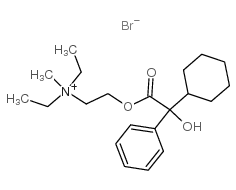Oxyphenonium (bromide)

Oxyphenonium (bromide) structure
|
Common Name | Oxyphenonium (bromide) | ||
|---|---|---|---|---|
| CAS Number | 50-10-2 | Molecular Weight | 428.40 | |
| Density | 1.2584 (rough estimate) | Boiling Point | N/A | |
| Molecular Formula | C21H34BrNO3 | Melting Point | 189-194° from ethyl acetate + alc | |
| MSDS | Chinese USA | Flash Point | N/A | |
| Symbol |

GHS07 |
Signal Word | Warning | |
|
Ultraviolet spectroscopic estimation of microenvironments and bitter tastes of oxyphenonium bromide in cyclodextrin solutions.
J. Pharm. Sci. 88(8) , 759-62, (1999) The UV absorbance and bitter taste of oxyphenonium bromide (OB), an antiacetylcholine drug, in cyclodextrin (CD) solutions are measured, and the local environment of the binding site and the reduction of the bitter taste intensity are quantitatively estimated... |
|
|
Solution structures of 1:1 complexes of oxyphenonium bromide with beta- and gamma-cyclodextrins.
Mol. Pharm. 1(2) , 166-72, (2004) The solution structures of complexes of oxyphenonium bromide (OB) with beta- and gamma-cyclodextrins (beta- and gamma-CDs, respectively) in deuterium oxide have been investigated by 500 MHz proton NMR spectroscopy and molecular mechanics calculations. The che... |
|
|
Electron paramagnetic resonance and electron nuclear double resonance spectroscopic identification and characterization of the tyrosyl radicals in prostaglandin H synthase 1.
Biochemistry 39(14) , 4112-21, (2000) The tyrosyl radicals generated in reactions of ethyl hydrogen peroxide with both native and indomethacin-pretreated prostaglandin H synthase 1 (PGHS-1) were examined by low-temperature electron paramagnetic resonance (EPR) and electron nuclear double resonanc... |
|
|
Safety pharmacology of a combination of tinidazole and oxyphenonium bromide.
Arzneimittelforschung 47(7) , 869-72, (1997) The effect of a combination of 150 mg tinidazole (CAS 19387-91-8) and 1 mg oxyphenonium bromide (CAS 50-10-2), referred to as the combination, was examined in various animal species to assess its safety. In mice and rats, the combination in the dose range 30-... |
|
|
Stability-indicating method for determination of oxyphenonium bromide and its degradation product by high-performance liquid chromatography.
J. AOAC Int. 90(5) , 1250-7, (2007) A high-performance liquid chromatographic (HPLC) method was developed for determination of oxyphenonium bromide (OX) and its degradation product. The method was based on the HPLC separation of OX from its degradation product, using a cyanopropyl column at amb... |
|
|
Cholinergic modulation of anaphylactic shock: plasma proteins influence.
Life Sci. 80(24-25) , 2342-6, (2007) Cholinergic drugs can modulate anaphylactic shock and change lymphocyte functions. Plasma proteins modulate effects of muscarinic antagonists during anaphylactic shock. The present investigation was carried out to study the antianaphylactic activity of methac... |
|
|
Effects of cholinotropic and cytostatic drugs on the development of Arthus reaction.
Bull. Exp. Biol. Med. 146(6) , 747-9, (2008) Antimuscarinic effects of ipratropium bromide and atropine are associated with prevention of the development of Arthus reaction, while the cytostatic effects of cyclophosphamide and doxorubicin lead to involution of the thymus and spleen, suppression of antib... |
|
|
Mechanism for the inhibition of contractile activity of the gastric antrum and pylorus in rabbits during psychogenic stress.
Bull. Exp. Biol. Med. 147(3) , 296-300, (2009) Psychogenic stress in rabbits (fixation to a frame) was accompanied by the inhibition of contractile activity of the gastric antrum and pylorus. These changes persisted during blockade of muscarinic receptors, nicotinic receptors, alpha(2)-adrenoceptors, and ... |
|
|
Role of cholinergic structures in individual resistance of rat circulatory system to posthemorrhagic hypoxia.
Bull. Exp. Biol. Med. 140(2) , 177-80, (2005) Experiments employing ultrasound technique showed that nonselective blockade of central muscarinic cholinoceptors with amizyl significantly increases the number and lifespan of rats highly resistant to acute massive blood loss. This pretreatment increased ind... |
|
|
Blood plasma proteins modulate the broncholytic effects of a muscarinic receptor antagonist.
Bull. Exp. Biol. Med. 145(1) , 55-7, (2008) Blood plasma proteins modulated the effects of muscarinic receptor antagonist methacin. Administration of methacin in combination with albumin or C-reactive protein (but not with IgG) abolished the broncholytic effect of methacin. It was probably associated w... |